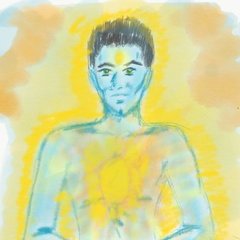-
Content count
8,420 -
Joined
-
Last visited
-
Days Won
77
Posts posted by dwai
-
-
Ditto on the fog (I saw this on a regular basis during early days after getting initiated by my teacher), and the torroid (during practice, especially circulating the energy)
-
 1
1
-
-
-
20 minutes ago, Gerard said:So, no practice in Chicago's snowfields?
Not in the snow

-
Was in the park yesterday morning, doing dao gong and Tai chi with my friends. We’ve been practicing at this specific park for close to 10 years now, normally from late spring through fall, as winters in Chicago are brutal.
As we were doing the meditation, I started to see what seemed like cobwebs of white light all over, all around us. It is interesting it was visible with both eyes open and closed.
Very interesting phenomenon, thought I’d drop this pebble in the proverbial pond and see what happens

-
 3
3
-
 1
1
-
-
Combining Mudras with specific pranayama works very effectively. What I learnt in Tamil Siddhar Yoga practice was a sequence of chin mudra --> chinmaya mudra --> aadi mudra --> merudanda mudra in combination with specific pranayama - very effectively raises the kundalini in the sushumna while also balancing the ida-pingala nadis. Very powerful stuff, but requires patience and preparation of the spinal column (both physical and energetic) for it to work.
-
 1
1
-
 1
1
-
-
She will be missed

May she be liberated.
-
 4
4
-
-
If you want to get to daobums
here are the rules
please send a prayer
and say thank you to Jules
-
 4
4
-
 2
2
-
-
23 hours ago, forestofclarity said:I'm not a particular fan of JS but have a few thoughts:
I think he misses the point here. Samadhi can be incredibly useful for shutting down the mind in order to obtain a clearer view of what is essential. The error arises when one mistakes a state of meditation with an essential state of being. Swami Sarvapriyananda describes this. If you want to view the screen, you can try to discern it while the movie is going, or you can shut down the projector to see it. The error arises thinking the projector needs to be shut down all the time. But to say that there is no lasting impact from the shutting down and rebooting misses the point and suggests a gap in meditation experience.
Ramana Maharishi also had similar comments on what he called “Manolaya” (suspension of the mind) as opposed “manonasha” (cessation of the mind). It is widely accepted that samadhi (nirvikalpa) is temporary and while it can be a very important step in the process, it is not permanent or complete.
23 hours ago, forestofclarity said:Depends on what is meant by knowledge. I would say jnana is knowing that does not occur in the intellect, as opposed to vijnana, but no distinction is made here.
it depends on what you mean by jnana

Tattva jnana is the direct realization of our true nature, but its effect is permanent in the intellect/mind. The mind is permanently changed.
23 hours ago, forestofclarity said:The "I" ness of I seems to dissolve, IMO.
This seems to contradict his earlier point. I don't agree with the "vedanta is intellectual" movement generally. I interacted with JS many years ago when he was just getting started. I told him I understood intellectually, but it was not a lived truth or reality. He said that it is was merely understanding plus confidence. I don't think this will stand up in the long run, and have come to learn the difference between intellectual understanding and realization. I don't think he does, or a least he didn't.
Then you have more exposure to him than I do. I only went by what I read in the short aphorisms he posted.
23 hours ago, forestofclarity said:
This says to me he doesn't understand the prior point. As they say in Dzogchen, experiences are like mist, they fade. Understanding is like a patch, it falls away. Realization is like space, unchanging. Swami S again does not make this mistake, and explains that intellectual understanding is a first step in the shravana, manana, nididhyasana. JS is only touching on the first two, IMO.
I don’t think he’s saying anything different. But that’s just how I processed his words. Someone else might process it differently.
-
1 hour ago, Lairg said:What objectives might Oneness have in causing the appearance of separation?
Why would Oneness want such a troubling species as humans?
That’s a wrong question imho. It is not that awareness wants this or that. The appearances are phenomena that arise in awareness due to ignorance.
From awareness point of view nothing has ever happened/is happening/will ever happen. But it is a bit hard for people to accept, so they are eased into the pool (so to speak)

-
 1
1
-
-
7 minutes ago, doc benway said:I find this segment a bit problematic and the message he is trying to get across, which I do get, could perhaps be better expressed:
What’s disowned… nothing was never disowned and is always ever-present.
…must be claimed… , who is claiming something and what are they claiming?
… through knowledge, not action… knowledge is often interpreted in a materialistic, objectified way, care is needed here
Action reinforces ignorance…. so can knowledge, particularly of the wrong kind or misinterpreted; and action can certainly express wisdom, removing ignorance, if engaged with full presence. Teaching, guiding, and pointing out are actions that dispel, rather than reinforce ignorance. With maturity and stability in our vew, meditation, and conduct, all action should dispel rather than reinforce ignorance.
What I take away from his aphorism is that the “mind” which “disowns” its true nature (due to ignorance), cannot perform actions to realize it. The realization happens in the mind, through subtle intelligence/discerning intellect (sukshma buddhi).
-
 2
2
-
 1
1
-
-
18 hours ago, Lairg said:Of course. The Oneness has Intent and thereby changes Its internal flows and thus the associated aspects of Existence
But really, there is nothing apart from awareness, things just appear to be separate. Like how in a dream the dreamer’s mind splits into subject (witness) and objects (dream world). There is no “world” apart from the dreamer’s mind. The waking reality is also like that
-
 1
1
-
 1
1
-
-
9 hours ago, Sherman Krebbs said:Sometimes it feels that there is a deeper, ethereal "knowledge" that transcends the analytical and linguistics knowledge of the mind. My intellect (as well as all other phenomena) are tools to keep me alive, which I can also use to connect with that deeper knowledge.
In Vedanta it is called “para” (absolute) and “apara” (local) jnana (knowledge). The deeper (para) knowledge is pure awareness (chit) itself. The local (apara) knowledge is knowledge of things. The pure awareness is reflected in the mind leading to local knowledge.
The way to know this awareness is simply by being aware. But it is so subtle, and the mind is so used to grasping at objects that this awareness is missed (but it’s always present, hidden in plain sight. That’s why the wise say “one is not even a hair’s breadth apart from Dao/Brahman”…
But really, there is nothing apart from awareness, things just appear to be separate. Like how in a dream the dreamer’s mind splits into subject (witness) and objects (dream world). There is no “world” apart from the dreamer’s mind. The waking reality is also like that.
-
 1
1
-
 1
1
-
-
30 minutes ago, Lairg said:In the Hindu tradition the human can learn to operate on many planes. On each plane the result is knowing (a state) rather than knowledge (a concept).
Knowing (verb) implies knowledge being acquired.
30 minutes ago, Lairg said:For example: how does a newborn human know how to breathe? Is that intellectual?
That is likely genetic memory. Most of the animal kingdom relies on it. Humans are perhaps the only exception beyond a certain age
30 minutes ago, Lairg said:
How does a mother know when her child is in danger when far away?
Intuition. What does this have to do with the OP?
-
 2
2
-
-
@zzR I’ve hidden your post as it shares copyrighted material. Please refrain from this in the future. On a different note, we would be happy to read your views on Toltec/nagual/tonal etc.
-
 1
1
-
 1
1
-
-
Quote8 Insights about Samadhi; Why Self Knowledge Transcends Discrete Mystic Experience(s)
1. Samadhi brought about by concentrating and stilling the intellect may yield Self knowledge, but it will disappear as soon as concentrated absorption in the silence ends. You can’t concentrate on one thing forever.
2. All knowledge, material or spiritual, occurs in the intellect. Ignorance also occurs in the intellect. You need to know the difference between knowledge and ignorance. If you do, you are free, because you will never choose ignorance because it causes suffering, whereas Self knowledge produces bliss.
3. Self-realization is Self-knowledge—understanding the “ever-present, ever-evident I” is non-dual consciousness, not a mystic experience.
4. Desires aren’t inherently evil; demonizing them is. Desire is essential for pursuing Self-knowledge viz. liberation. Desires that don’t cause you to break dharma are fine. Nothing is created without desire. Evil…injury to yourself and others…is caused by immaturity aka ignorance of your benign unborn whole and complete ordinary aware-full Self.
5. Enlightenment isn’t a destination attained by following a path; it is reclaiming our disowned nature by exposing the mind/intellect to Vedanta, the science of Self . What’s disowned due to ignorance must be claimed through knowledge, not action. Action reinforces ignorance. It does not remove it.
6. Dismissing Self knowledge because knowledge is “merely intellectual” is a “merely intellectual” conclusion based on the idea that thinking and awareness are in different orders of the one non-dual reality. Life is a both/and, not an either/or.
7. Any means of knowledge that reveals that the ever-present I is whole and complete is Vedanta. The word Vedanta simply means “the knowledge that ends the quest for new experiences and new knowledge, which does not imply that new experiences and new knowledge are undesirable or unenjoyable.
8. A skilled Vedanta teacher can convey the message directly to a prepared seeker, which does not imply that every Vedanta teacher is skilled. Vedanta teaches freedom, not Vedanta.
-
 2
2
-
-
24 minutes ago, Lairg said:An interesting proposition from two points of view:
- managing personal experience allows experiments to test theories/beliefs
theories and beliefs are basically stories we tell ourselves to explain the inexplicable.
24 minutes ago, Lairg said:- "truth" in philosophy is a reification - the quality of being true to a statement/relationship/situation is turned into a noun/object that does not need a context, and therefore holds without limits, in every case
https://en.wikipedia.org/wiki/Reification_(fallacy)
That might be the case in western philosophy. Indic philosophy (Hinduism, Buddhism) clearly consider that there is an absolute reality/truth which is the ground of all phenomena.
-
 1
1
-
-
2 hours ago, Neirong said:I am not interested in chatting with book quotes, if there is no personal experience there is nothing to discuss.
If it is personal “experience” it is still a phenomenon, and therefore not the Truth.

-
On 2/28/2025 at 12:51 PM, doc benway said:An alternative perspective - no one needs to teach a child to walk or run. It happens naturally and spontaneously, when they are ready - ziran. Wisdom can also happen naturally and spontaneously. In many ways, I suggest that it is the infatuation with “cultivation” and “energy” that can be dysfunctional and counter-productive for a lot of people
I think it boils down to the question each spiritual seeker has to answer for themselves - "What do you want?"
If they want "cultivation" and "energy", they'll follow a path that does that. If they want to realize the Truth, they will follow a path leading them to it.
I love the Kashmiri Shaivism's "methods" terminology -
- For very few "anupaya upaya" - spontaneously revealed
- For a slightly larger group, "shambhava upaya" - revealed through self-inquiry
- For a somewhat larger group than the above, "Shaktopaya" - revealed through preparation of the energy-body and then the mind through self-inquiry
- For most people, "Anvopaya" is how the Anu (Atom) builds the body, the energy body, and then works on the mind.
It could be a combination of all four because the final realization happens spontaneously, on its own. It's just that the "level" of the seeker determines their access at a given point in time.
Mostly, people who have trouble with the "spontaneously happening" realization haven't reached a point where they can intuitively 'get it' (this can happen even before realization occurs). Another could be attachment to method(s). It can be a subtle (or gross) attachment to an identity manufactured by the ego (for example, I am a (fill in the blanks) master. I have spent (fill in the blanks) decades on developing skills in the (fill in the blanks) path).
-
 1
1
-
On 2/24/2025 at 7:14 AM, doc benway said:When you “get it,” referring to realizing, direct understanding of, “the highest spiritual teachings” in Tibetan Buddhism, you realize it’s been staring you in the face the entire time. There’s never been a moment you were a hair’s breadth away from it, and yet you just couldn’t see it. If your karma is not right, you won’t get it, no matter how it is presented.
It's the same Advaita Vedanta.
-
Issues should be resolved now. We were able to reach Jules and they’ve fixed the issue (disk ran out of space due to a log file getting full)
-
 2
2
-
-
Are folks still getting the timeout issue? Things seem to have been better for the past 24 hrs for me.
-
I think the teachings themselves have not been "secret" but are only limited to those worthy of them. Who can decide about a seeker's worthiness? One who has been authorized to teach can. If they have been authorized, the assumption is that they also have the capacity to discern between casual seekers vs. thrill seekers vs. spiritual crows vs. genuine seekers (there are many more categories, I'm sure).
-
1 hour ago, stirling said:I don't think the owner has been back in touch with us admins yet, though we have reached out.
Trunk left a voicemail for Jules on the number he had, and afaik hasn't heard back yet.
-
 1
1
-
-
On 2/7/2025 at 5:05 PM, Nintendao said:is the LAMP just limping or is there a DDOS going on? I know how to read var log http if you need backup.
It is likely an issue on the server side. There’s no indication in the logs that point to a DOS/DDOS.
-
 1
1
-




Damo Mitchell – Any Verifiable Demonstration of Skill or Qi Emission?
in General Discussion
Posted
Having no "horse in this race", I would say, I find Damo's online persona a bit off-putting. I think he and his mate Adam do posture a bit to provoke reactions
As far as abilities go, I would agree with @forestofclarity that he probably focuses more on "power" than wisdom. Personally, fwiw, I know a few teachers who are far more humble and capable than both of them, but they are young (relatively speaking), and therefore have opportunity to grow (especially in the wisdom department). I also like Mark Rasmus a lot more than either of those worthies, simply because he is matter of fact and direct, and comes across as being a lot more genuine.